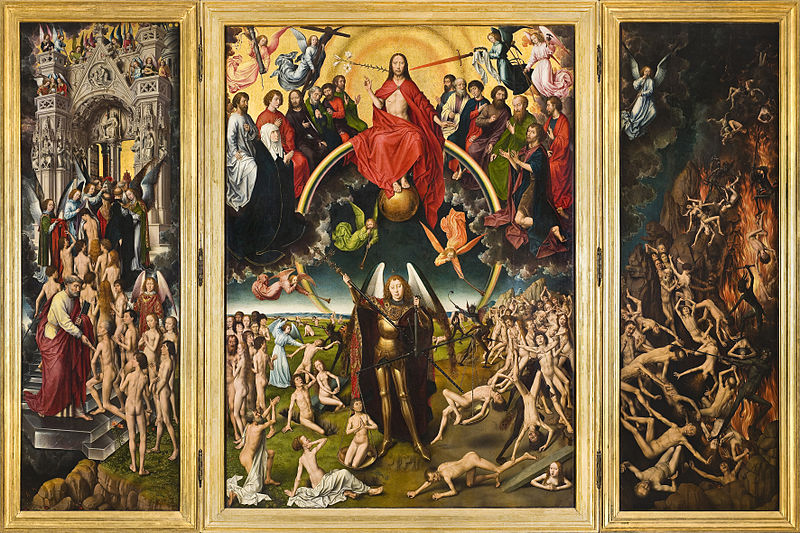 I have been reading first is "The Waning of the Middle Ages", for almost a century a staple read for those interested in the history of medieval Burgundy.
I have been reading first is "The Waning of the Middle Ages", for almost a century a staple read for those interested in the history of medieval Burgundy.Amazing, vigorous accounts of times in the once vast and powerful reign spanning almost from the South of France to the Netherlands. A rich, often ruthless, eccentric, unjust, opulent yet extremely interesting and vigorous culture that radiated its influence with development in social forms, in art and literature.
The book has been in print, in various editions repeatedly. It has received some criticisms, but - who cares about critics, it still stands as a great read.
It is an older, Polish edition as Antony was a predominantly Polish reader. The illustration on the cover show a sample of courtly portraiture that flourished at that time.
 |
| Portrait of a Young Girl, ca 1470 |
The genre of young girls portraits became well established in those times as portraits of young "well-born" ladies was an indispensable tool of the matchmaking, the political power arrangement.
The looks mattered, the manner of the sitting was usual formal, the clothes, the jewels and head pieces are now such invaluable window into the way of life at the courts of Europe.
Young ladies at the onset of puberty, often around the age of nine were considered suitable for the marriage negotiations.
In the past, I used to reproduce some of those most beautiful early portraits of young women.
They were usually small, 10 -12 inches max canvases, gloss-varnished and framed in the most antique looking frames I could find.
I think I have neglected my favourite pastime a bit - I should catch up.
 |
Margot Valois by Jean Clouet, 1560 |
This painting is no longer medieval, but show the continuation of the popular tradition.
It is of the portraits from much later period which I reproduced, enhancing the image file of course considerably, was this one. Beautiful painting that led bringing closer Valois with the rest of the Burbons, and to her becoming the wife of the King of France and Navarre, as the wife of Henry IV.
Remember the movie "Queen Margot" with Isabelle Adjani?
 |
| Elisabeth of Austria, ca 1571 |
Jean Clouet was an accomplished and well sought portrait painter.
Tradition, again, was continued by Jean's son, François Clouet.
Another young and impressively clothed and adorned young lady, later queen of France, wife of Charles IX. ->
 |
| Catherine of Aragon |
He made his fame and impressive honoraria at the court of the Isabella of Castile* who recommended his skills to Elisabeth, the French Queen. Both ladies were of the Habsburg house, first by marriage, the second by birth.
This exquisite portrait is that of Catherine of Aragon. Staunchly Catholic, the rim of her head-piece and piously lowered gaze suggests the aura of sainthood. She was the daughter of Isabella of Castille and later, the famous first wife of the "infamous" Henry the VIII.
Michel Sittow was trained under Hans Memling likely in Bruges.
 |
| Last Judgement, triptych, Hans Memling |
Memling continued in the style of Rogier van der Weyden, the Early Flemish painter who, is said, in his days eclipsed van Eyck.
Memling did not specialize in portraiture, but specifically in large religious compositions, with "The Last Judgement" triptych being one of his most magnificent paintings.
 Rogier van der Weyden worked in Dutch-speaking Brussels at the court of Philip the Good, a great patron of the arts - the Duke of Burgundy and Count of Artois.
Rogier van der Weyden worked in Dutch-speaking Brussels at the court of Philip the Good, a great patron of the arts - the Duke of Burgundy and Count of Artois.And that's were much of "The Waning of the Middle Ages" takes place...
Oh, to be in Bruges!
 |
| Titian, Isabella of Portugal, 1548 |
No longer Medieval in style, but clearly renaissance by Titian - portrait of Isabella I of Portugal. This woman was a granddaughter of the powerful Spanish queen Isabella of Aragon*. It has been said that she was a woman of uncanny beauty.She died young leaving many unconsoled.
And last (for now) the portrait of Anne of Cleves, another wife of Henry the VIII.
She was not the most beautiful of the wives, but certainly she has been the subject of one of the most beautiful portraits of all times.
 |
| Hans Holbein the Y, Anne of Cleves, ca 1539 |
Painted by Hans Holbein the Younger, she must have captivated him by a particular demeanor and definitely by this amazing outfit.
 |
| Lucas Cranach the Elder, Sybille of Cleves, 1526 |
Holbein was a Protestant and his style clearly represents the interests of Renaissance. He made considerable career in England after being recommended by the fellow Reformer, Erasmus of Rotterdam to Thomas Moore.
This portrait is of Anne's sister - Sybille of Cleves.
Painted by Lucas Cranach the Elder. Different painter, different dress...
 |
| Judith with the Head of Holofernes ca 1530 |
The is another portrait of a young woman that needs to me mentioned:
I have written about L.Cranach E. more here.
It's a beautiful painting.
I know, this head... Hmmmmm. I don't know...
Holofernes was apparently a bad dude, but she did him really bad and Lucas Cranas the Elder somehow delighted in the theme....
It has even became one of the favourite themes of art history for a while.
Could it be proto-Feminism, like: Look what can happen to you if you....